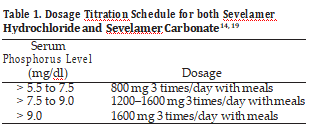

 2021-08-18
2021-08-18
Becauseoftheapparentriskofsevelamer hydrochloride–associated metabolic acidosis in patientswithCKD,sevelamercarbonatewas developedasanimproved,bufferedform. Sevelamercarbonateisananion-exchangeresin with the same polymeric structure as thatof sevelamerhydrochloridebutwithcarbonate replacing chloride as the anion. This anion replacementattheaminoterminalprovides alkaline properties that may benefit patientswith CKD.27
In a recent, randomized, double-blind,crossover studyof79patientsreceivinghemodialysis, sevelamercarbonatewascomparedwithsevelamer hydrochlorideintermsofphosphatebinding ability,effectontheserumlipidprofile,andeffect on serum bicarbonate concentrations.28 Both agentswereexpectedtoactsimilarlyinallareas exceptthelast.Patientscompleteda5-weekrun- inperiodwithsevelamerhydrochloride.Forthe next 8 weeks, one group continued to receive sevelamerhydrochloridewhiletheotherreceived sevelamercarbonate.Duringthefinalphase,the drugswereswitched,andpatientsreceived treatment for another 8weeks.
Serum phosphorus concentrations were equally
controlled during treatment with sevelamer carbonate (mean ± SD 4.9 ± 0.9 mg/dl) and sevelamer hydrochloride (4.7 ± 0.9 mg/dl). Serum bicarbonate concentrations increasedwith sevelamercarbonatebutnotwithsevelamer hydrochloride. This increase wassignificant, withconcentrationsrisingfrom21.1±3.8mEq/L to 22.4 ± 3.7 mEq/L (p<0.001) in the sevelamer carbonategroup;theyremainedessentially unchanged at 21.1 ± 3.8 mEq/L to 20.8 ± 3.7 mEq/L(p=0.833)inthesevelamerhydrochloride group.
Specific gastrointestinal adverse events were similar between the groups; however, more were reportedwithsevelamerhydrochloridethanwith sevelamercarbonate(45vs25,p=0.007). However, no statistical significancewas detected in the numbersofspecificgastrointestinaleventsbetween groups when they were broken downinto
categories such as nausea, vomiting, and constipation. This observation suggested that both drugs had similar gastrointestinal adverse- effect profiles.
Sevelamercarbonatemaybemostbeneficialforpatients who are not dialysisdependent.In contrast to patients receivingdialysis—whomaymitigatetheriskofdevelopingmetabolicacidosisbyadjustingthebicarbonateconcentrationsofdialysates—nondialysis-dependentpatientswith stage 3 or 4 CKD do not have thisoption.Theefficacyandtolerabilityofsevelamercarbonatein patients with nondialysis-dependentCKDwasrecently examined in 19nephrologycentersacross Northern EuropeandAustralia.29Investigators initially screened 129 patients,41ofwhom participated in the study. Frombaselineto the end of the 8-weektreatmentperiod,sevelamer carbonate loweredserumphosphoruslevels by a mean ± SD of 1.4 ±1.0mg/dl(p<0.001). Furthermore, 75% ofpatientswith stage4CKDachievedtheserumphosphorusgoal of 2.7–4.6 mg/dl set by theresearchers. Ofnote,serum bicarbonateconcentrationssignificantlyrose from 16.6 ± 3.6 mEq/L to 18.2 ±3.7mEq/L(p=0.005). These data support theuseofsevelamer carbonate inpredialysissituations,especiallyifpatientsmaybeatriskformetabolicacidosisbasedonserumbicarbonateconcen-trations. It is important to note,however,thattheU.S.FoodandDrugAdministrationhasapproved neither sevelamerhydrochloridenorsevelamer carbonate for thetreatmentofhyperphosphatemiainthepredialysispopulation.ThepossibilitythatsevelamercarbonatemayhavebenefitsinCKDextendingbeyondphos-phoruscontrolhasbeenexplored.Astudyusingan animal model foundothersurprisingadvantages of sevelamer carbonatethatincludedeffectsonvascularcalcifications,stimulationofbone formation, and treatment ofadynamicbonedisorders.3Inaddition,thisstudyconfirmedthedose-dependenteffectofthisdrugonserumphosphorus concentrations, whereasitslipid-lowering abilities and effectsonvascularcalcificationsappearedsimilaratthe1%and3%
concentrations studied.
Both sevelamer hydrochloride and sevelamer carbonateareeffectivephosphatebinders. However,calciumacetate,analternativeagent that has been on the market for a long time, is alsostilleffectiveformanaginghyperphosphatemia.
IntheCAREstudy,bothsevelamerhydrochloride andcalciumacetateeffectivelyreducedserum phosphorus concentrations, but the calcium acetate didsotoagreaterextent.10Inaddition,theannual cost of sevelamer hydrochloride was$4283 comparedwith$732forthecalciumacetate.10
Sevelamer (both hydrochloride and carbonate) isarelativelyexpensivetreatmentforhyperphos- phatemiacomparedwithcalciumacetate.Costs are$2.05/tabletforbothsevelamerformulations and $0.49/tablet for calcium acetate. If patients aredosedbasedstrictlyonthemanufacturer’s guidelines,thencostsforbothsevelamerformu- lations range from $2214–4428/year, whereas for patientsreceivingcalciumacetate,theannual cost is$529–1587.30
Both sevelamer hydrochloride and sevelamer carbonateofferadditionalbenefitsinreducing low-density lipoprotein cholesterol levels and decreasingthefrequencyofvascularandvalvular calcifications.31–33
Although serum bicarbonate reductions and metabolicacidosisareconcernswithsevelamer hydrochloride, they may be less of an issue in patientswithend-stageCKDreceivinghemodialysis orperitonealdialysisthaninthepredialysis population,asbicarbonateconcentrationsinthe dialysate may be adjusted accordingly. In one study,aslong-termtreatmentofmetabolic acidosis, the bicarbonate concentration inthe dialysatebathwasadjustedforpatientsreceiving sevelamer hydrochloride.34 Still, for patients who are not yet undergoing dialysis or for those at riskformetabolicacidosis,sevelamercarbonate offersthesamebenefitsassevelamerhydro- chloridewithoutthenegativeeffectonserum bicarbonate concentrations. Adverse-effect profilesforbothagentsappeartobesimilar,and counselingforpatientstakingeitherdrugor changingfromonetotheothershouldfocuson thepossiblegastrointestinaleffectsthatthey mightexperience.
Sevelamer hydrochloride and sevelamer carbonate are started at the same dosageof 800–1600 mg taken 3 times/day with meals. Dosagetitrationisbasedonserumphosphorus concentrations (Table 1).14, 19 A powder formulationofsevelamercarbonateisbeing investigatedandmayallowforonce-dailydosing. However,datafromearlyclinicalstudieshave been conflicting.35,36
Hyperphosphatemia is a common complicationof CKD, and it is most prevalent in stages 3–5. Sevelamer hydrochloride and sevelamer carbonatearebothion-exchangeresinsthatbind phosphate in the gastrointestinal tract and lower serum phosphorus concentrations. Bothdrugs also decrease low-density lipoprotein cholesterol levels, and they are less likely than calcium- containingbinderstocausevascularcalcifi- cations. Effects on serum bicarbonate levelsare morefavorablewithsevelamercarbonatethan with sevelamer hydrochloride. For thisreason, sevelamer carbonate may eventually replace sevelamerhydrochlorideasthephosphatebinder of choice for patients who cannot tolerate calcium-basedbinders.
